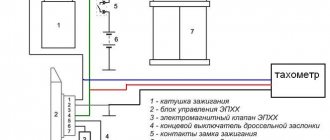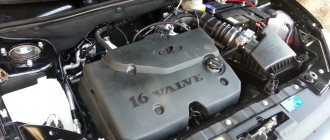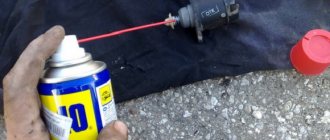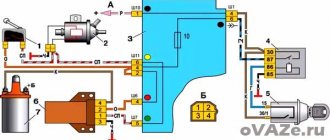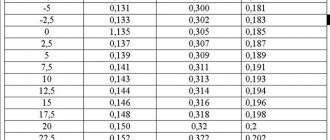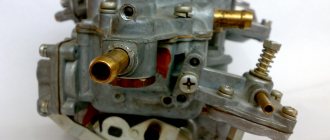Objectively, the carburetor installed on Oka cars has a simple design. And if you use it correctly, then no problems should arise.
The main thing here is to respond to changes in a timely manner, and also not to waste time and effort.
The carburetor is the main working element of the engine on the VAZ 11113. Depending on the period, different modifications were installed on the Oka. But in general their device was the same. The difference was observed only in certain settings.
Device
Oka first appeared on the Russian market in 1987. The production continued until 2008.
The first was the VAZ 1111 version. This is a car with a 2-cylinder engine and a 0.65-liter engine.
Then an updated version of the VAZ 11113 appeared. It has been produced since 1995. Here the engine already had a volume of 0.75 liters.
For the first version of Oka, a DAAZ 1111 carburetor was developed. For the subsequent modification with a 0.75-liter engine, carburetors of the DAAZ 11113 series were used. Then they were slightly adjusted.
Objectively speaking about the old carburetor is almost pointless. There are fewer and fewer cars with it. Yes, and the settings are carried out in the same way as on the updated version.
The DAAZ 11113 carburetor is a device that creates an air-fuel mixture in factory-specified proportions. This ensures stable operation of the internal combustion engine, regardless of the currently selected mode.
The body is made of 3 elements:
- top cover;
- the main part that comes with the float chamber;
- the lower part where the throttle valves are located.
The device itself is two-chamber. Sequential opening of existing throttles is provided.
Structurally, it is worth highlighting the following components:
- GDS. This is the main dosing system. Works in all available modes. It consists of diffusers, fuel supply jets, as well as air jets in both chambers.
- XX. This is the idle system. Serves to maintain stable operation of the internal combustion engine at minimum speed. Helps you use fuel wisely.
- Economizer. Helps enrich the air-fuel mixture when the speed increases and the engine operates under a fairly high load.
- Acceleration pump. Its main task is to work smoothly without noticeable failures. Even if the driver presses the gas pedal sharply.
- Starting device. Aimed at stable starting of the car engine in any weather.
- Float chamber. Ensures that a constant level of flammable liquid in the carburetor is maintained so that the engine runs stably;
- Transitional system. Helps to accelerate smoothly, eliminating jerking when the secondary chamber opens.
Each component of the system has its own specific task.
To set up and adjust the unit, special adjusting screws are used. Tuning is also carried out by selecting jets and changing the angles of the throttle and air dampers.
Actual gasoline consumption on the Oka River
During the operation of the car, owners are faced with the problem of increased fuel consumption. The main reasons for this are overload and improper throttle control (during factory tests, professional testers are behind the wheel).
As the piston group and valves of the gas distribution mechanism wear out, the compression ratio drops and engine power decreases, which leads to additional fuel costs.
Oka with a 0.6 l engine
Actual fuel consumption on cars with a VAZ-1111 engine:
- In city mode, the adjusted engine consumes up to 7 liters of fuel in summer; in winter, the parameter increases to 8 liters due to the need to warm up the engine and slow down the traffic flow. As parts of the power plant and chassis wear out, fuel consumption reaches 9 liters.
- On the highway, the minimum consumption of 3.5-4 liters is achieved at 60-70 km/h; increasing the speed to 90-100 km brings gasoline costs to 6 liters per 100 km. Accelerating a car to maximum speed leads to an increase in consumption to 8-9 liters (due to the increased crankshaft speed and increasing aerodynamic drag).
- In the combined cycle (50% of city mileage), the car requires 6-7 liters of fuel (depending on load and ambient temperature).
0.7 l engine
When using a carburetor VAZ-11113, the consumption during operation is:
- In city traffic, the car consumes about 8 liters of gasoline with an octane rating of 92 or 95 units (the increased cylinder capacity negatively affects engine efficiency). Sharp acceleration or operation in winter leads to an increase in consumption to 9 liters.
- The additional power has a positive effect on gasoline consumption on the highway, which is in the range of 4.5-5.5 liters per 100 km at speeds of 80-90 km/h. Acceleration to 110-120 km/h leads to an increase in fuel costs to 6.5-7 liters.
- In an average driving cycle, a car requires 7-7.5 liters of fuel per 100 km in summer and up to 8-8.5 liters in winter.
Engine 0.8 l
When using a Chinese engine with distributed injection, fuel costs are:
- In urban conditions with a short-term warm-up of a cold power plant (for 10-15 seconds before starting to move), gasoline costs are 7.5-8 liters, which is lower than the characteristics declared by the factory. As the engine wears out or if the throttle assembly becomes dirty, the consumption reaches 8.5-9 liters of fuel.
- On the highway, with the cabin fully loaded (4 adults) and a speed of 90 km/h, the car burns about 6 liters of fuel. The increased torque power allows you to accelerate the car to 150 km/h, consumption in this mode reaches 10-11 liters of gasoline.
- In mixed operating mode, the engine consumes 7.5 liters of fuel, the fuel reserve is enough for 420-430 km without refueling.
Engine carburetor 1.0 l
The installation of MeMZ-245.1 engines with a reduced compression ratio, designed for A-80 gasoline, was carried out from Naberezhnye Chelny. Small-scale vehicles are rare, which determines the small amount of information about actual fuel consumption. According to owners' reviews, in city traffic the car can handle 6.5 liters of fuel, and on the highway at 90 km/h gasoline costs do not exceed 4.5 liters.
The use of a 5-speed gearbox helped improve efficiency, but the crankcase of the unit did not fit in the engine compartment of the car.
How it works
The operation of the carburetor in question on Oka cars is based on the same principle as similar systems on other wheeled and widely used vehicles.
- First, fuel from the float chamber enters the well through the fuel system to form the air-fuel mixture.
- The nozzles then transfer the mixture to the diffusers of the main component, that is, the carburetor.
- The device responsible for idling takes gasoline from the wells. It follows the jets and forms a mixture with oxygen in specified proportions.
- Air coming from the second and first carburetor chambers is also added to the components.
- When the throttle is opened slightly, the gasoline mixture moves into the chamber. If the fuel fluctuates, the economizer regulates this phenomenon and stabilizes engine operation.
When ignited, the air-fuel mixture creates a force that allows the crankshaft to rotate and thereby set the wheeled vehicle in motion. In this case it is Oka's car.
Principle of operation
The VAZ-11113 carburetor works on the same principle as the Solex. The essence of the operation is very simple - the float chamber constantly contains gasoline, which, due to rarefaction through the gas pump, is mixed with the air flow, forming together with it an air-fuel mixture.
It all works like this - the driver uses the gas pedal to act on the throttles, thereby changing the flow rate of air sucked into the cylinders.
The air flow passing through the diffusers creates a vacuum in the nozzles, which causes the fuel in the float chamber to be sucked in. The gasoline sucked in by the flow passes through the fuel nozzle, which, thanks to the small cross-section of the hole, breaks the liquid into small droplets, which makes it easy to evaporate. And already in evaporated form, gasoline is mixed into the air through a sprayer.
The engine operates in different modes, to which the GDS does not always have time to adapt (it needs to dispense the amount of gasoline), which can cause dips and jerks.
To eliminate such problems, an economizer and an accelerator pump are included in the carburetor design. The first provides an increased amount of gasoline at high engine loads. This is done by supplying part of the fuel to the atomizer, bypassing the fuel nozzle.
Article on the topic - OKA lubrication system
The accelerator pump is responsible for supplying the required amount of gasoline when the throttles are opened sharply. He does this by injecting fuel through an additional nozzle. That is, when you sharply press the gas, gasoline is supplied into the air flow not only through the hydraulic system, but also through the accelerator atomizer.
Engine operation at idle is ensured by the idle speed system. It consists of channels through which fuel is supplied to the lower dampers. The air required for engine operation when the throttles are closed enters through holes made in the dampers. Therefore, even with the accelerator fully released, the combustion chambers are supplied with the air-fuel mixture necessary for the engine to operate at the lowest possible speed.
How to clean a carburetor
Before you start adjusting the carburetor on the Oka, you must clean it. It is pollution that is the main reason for unstable engine operation on these machines.
The carburetor unit becomes clogged over time. Especially if you use low quality fuel. Dirt penetrates the jets, as well as the fuel channels.
This may result in the following symptoms:
- loss of idle speed;
- the engine does not gain speed;
- the effect of engine tripping occurs;
- fuel consumption increases;
- Black smoke comes out of the exhaust pipe.
In many of these situations, major repairs are not necessary. It’s enough just to clean the system and then start adjusting the carburetor on the Oka 11113.
Practice shows that most often the HDS channels become clogged when the engine does not gain speed when the damper of the first chamber is opened. Although the idle speed does not disappear.
Here you should remove dirt using compressed air without removing the carburetor.
The meaning is this:
- turn off the Oka engine and raise the hood;
- remove the air filter housing;
- use a pump, blower or compressor to blow out the channels from the GDS;
- start the engine;
- check the stability of its operation.
If the behavior has become normal, then the filter is put in place and the machine continues to be used. If not, then you need to blow it again.
How to adjust the fuel level
Another important point on how to properly and completely tune a simple carburetor installed on an Oka car.
Sometimes the owners of this domestic small car are faced with such a problem. The fuel level in the float chamber decreases. It turns out to be noticeably smaller than recommended. This causes the mixture to become lean. As a result, the car accelerates with difficulty, fuel consumption increases, etc. If the level increases, then the appetite also increases. In both situations, you need to adjust the position of the float.
Self-adjusting the fuel level in the carburetor of Oka cars should not cause any particular difficulties. It is important to remember the following. When the carburetor fills with fuel, this indicates problems that have nothing to do with adjustment. Most likely, the locking needle does not fit tightly enough to the seat. The problem with the situation is that adjusting the fuel level will not in any way correct the situation in the carburetor of the Oka small car. You will have to completely change the locking mechanism in the chamber.
When the level is low and there is not enough gasoline in the chamber, a simple adjustment will help correct the situation. You don't need any special skills to work.
The instructions are presented as follows:
- remove the air filter cover;
- disconnect the choke cable;
- disconnect both fuel hoses, that is, the supply hose, as well as the return;
- unscrew the 5 screws that secure the top cover;
- check the condition and remove the cover along with the gasket to the side;
- arm yourself with a caliper or a cut piece of a ruler;
- measure the distance between the upper edge of the housing and the surface of the fuel;
- Normally, this distance for Oka is 22-23 mm;
- if the actual data differs, you need to bend the float tongue to one side;
- bend the tongue until the distance corresponds to the norm;
- If the adjustment is successful, return the cover and filter to their place.
Now you understand how you can adjust the fuel level inside the carburetor float chamber on the Oka yourself. But you need to remember one thing. When making adjustments, the locking needle may fall out when removing and installing the cover.
Overfills the carburetor
Often on the Oka a situation arises when the carburetor floods; with such a malfunction it is usually very difficult to start the car, and in other cases the engine does not start at all. There may be several reasons for the problem:
- does not hold the needle valve;
- the fuel pump creates too much fuel pressure (if a return line is not installed);
- the level in the PC is set incorrectly (more than normal);
- The float is not sealed.
Finding the cause of the defect usually begins with inspecting the parts of the float chamber, and if there is significant overflow and smells of gasoline, first of all you should pay attention to the locking mechanism.
How to stabilize idle speed
Several symptoms indicate problems with idle speed:
- idle speed disappears altogether;
- the engine behaves unstably at low speeds;
- The engine stops spontaneously and stalls.
In certain situations, such phenomena require removal of the carburetor. And this is a troublesome matter. But first, it makes sense to try to solve the problem without dismantling it. Purging is applied.
To clean the idle air system channels, you must:
- turn off the engine;
- remove the air filter cover;
- disconnect the power cable;
- unscrew the solenoid valve from the XX system;
- close the channel with your finger in the area where the solenoid valve was disconnected;
- start the engine of the car;
- give gas;
- let the power unit run for a while;
- Blow out the jets and valve with compressed air;
- return everything to its place;
- connect the power wire;
- use the quantity screw to add speed and start the internal combustion engine.
If the cleaning was effective, then the engine will run when idling. But the speed will be increased.
Then you need to tighten the quality screw and adjust the fuel mixture. Tighten until the internal combustion engine begins to reduce speed and show slight signs of failure.
Next, unscrew the quality screw a little. Until the engine starts running stably. Using the quantity screw, set the idle speed to normal. For Oka cars this is about 850-900 rpm.
In a situation where purging does not give the desired result, you will have to dismantle the carburetor, disassemble the element, and also thoroughly clean it.
